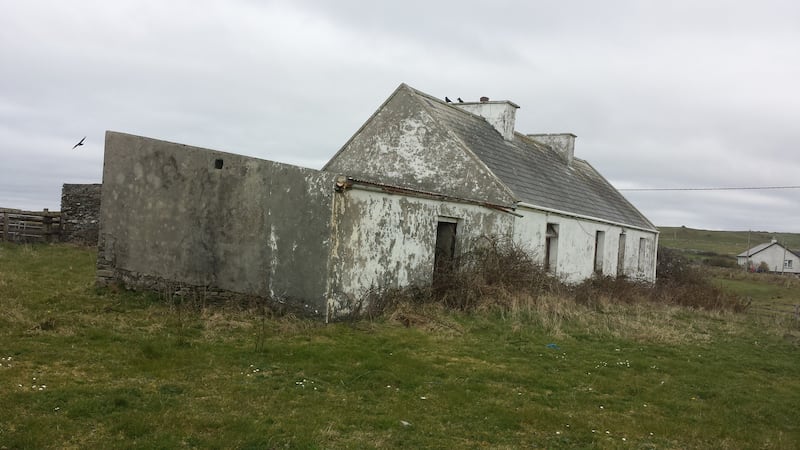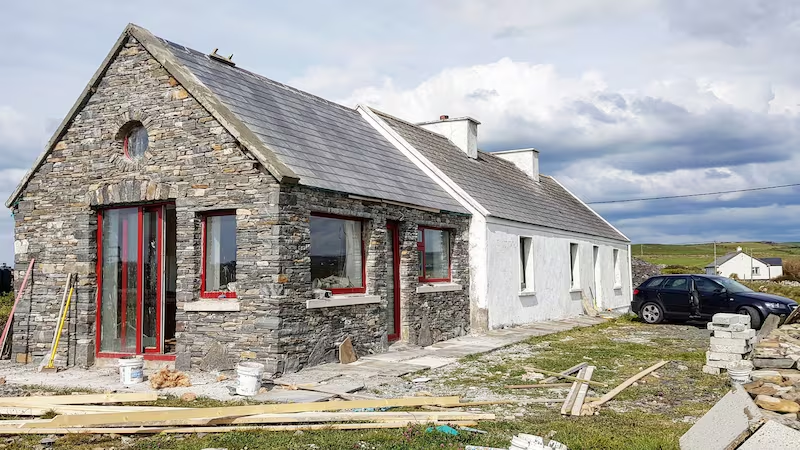When Ray Foley, an environmental officer with An Taisce, started looking for an old cottage he could renovate in Co Clare, he never realised the challenges that lay ahead and what he would end up building.
The 36-year-old first came to Clare as a surf-hungry teenager from "a surf-starved" Cork and that area of the wild Atlantic has drawn him back ever since. After graduating from art school and a period spent travelling, he arrived back to an Ireland in the throes of a deep recession and seeing many people getting burnt in negative equity, decided he wanted nothing to do with mortgages.
However, having secured his first full time job with An Taisce in 2012 and then living in Galway, the idea of acquiring a cottage in Clare at a reasonable price seemed like a good idea and one way of avoiding having to rent and continually move house as he had done more than a dozen times. In the event he managed to secure a mortgage of €90,000 from the bank and set off to find something suitable.
One day searching for one cottage, he spotted another on a hill and inquired locally about its owner and discovered that he now lived in the UK and had inherited it from an uncle. Once he knew his surname, Foley started “scouring” London phonebooks and making numerous calls before finally locating the man in question. The cottage, mentioned in the 1911 census, on nearly 1.2 hectares (3 acres) was considered derelict and having been advised on its value, Foley offered €55,000.

“On June 1st, 2016 I got the keys – in reality that was just permission to push open the front door and undo the baling twine around it. I thought with new windows and doors it would not be a million miles away from being lived in,” he says. “There was an old turf shed at the back facing south and I wanted to turn it into a living space, but it was a ruin, so that’s when the idea of building evolved and the next thing I knew it was a 600 sq ft extension.”
Restrictive demands
Given the bank’s restrictive demands about the building requiring detailed information about work and tradesmen involved in an extension etc, Foley took a €60,000 mortgage instead and topped it with a €30,000 credit union loan. “I didn’t have the money for an architect but having been at art school and knowing about Photoshop I drew up the planning application myself, which only cost €200.”
The first thing he did was to plant trees around the area in August 2017, “but the real work began at the end of that year,” he says, acknowledging the help of a local family called Flanagan. “Michael helped me to understand levels and how to lay foundations. His father did blockwork and recommended a carpenter who helped with the roof. My sister and her Swedish boyfriend helped to lay €1,000 worth of concrete for the foundation – a day’s work. Both of my brothers are engineers and I wanted the building to be environmentally friendly, so the house is timber-framed with stone cladding on the outside”.
The building took longer than planned in between breaks travelling abroad. Work continued throughout 2018 with the toughest and most time-consuming part the stonework and cladding. “I would come home from work and spend four hours every evening to produce only one square metre of stone. It’s a massive jigsaw but it did teach me that you can look for 20 minutes for the perfect stone or go at one with a hammer and chisel until it is perfect.” The main timber-frame structure was built over one wet weekend in October with his brothers.
Today, the house is complete, the old turf shed is now a habitable one-bed apartment with kitchen, bathroom and wood-burning stove.
"It has taken me three years and has been a huge draw on my time. You come to realise that time and money are very similar things. Some jobs can save you money; the stonework would have cost me between €6,000 and €7,000, but it cost me hundreds of hours. The tools needed to start with included a chop saw, a good screw gun and a grinder, and once you follow certain rules – things being square and plumb for starters – there is very little that's technically difficult about building. YouTube was an amazing resource."
‘Wish I had known’
What is his advice for anyone thinking of going it alone? “I would consider other people’s advice very carefully. Do your homework. Planning and sequencing are a huge component, which I wish I had known back then. Some things are worth the effort, others not. I didn’t do the electrics, for instance. Inherently damp cottages have big difficulties. Don’t necessarily go to a standard builder because they prefer to start with a clean slate.
“Bring someone who has done up a cottage before – they can flag problems straight away. Are the walls straight? Is there water ingress? Has it been plastered with lime and then rendered over with Portland cement as was done in the 1960s and 1970s, which can cause moisture movement through the walls? Cement plaster is like putting a plastic bag over the house. It can’t breathe and the water builds up on the inside of the walls.”

Now that it is finally finished, he describes it as “satisfying when you come out the other side. I am immensely proud, and it is amazing the way it has turned out.” His job entails teaching primary school children about climate change and the environment, so being surrounded by wildlife gives him particular pleasure. “I have seen foxes, badgers, newts, frogs, hares, kestrels and loads more. I spent most of my childhood exploring places like this, so it is cool to have it all in the front garden now.”
Share your home story: Have you recently extended, renovated or built your home? If so, we'd love to hear how you got on. Please email: homeanddesign@irishtimes.com



















